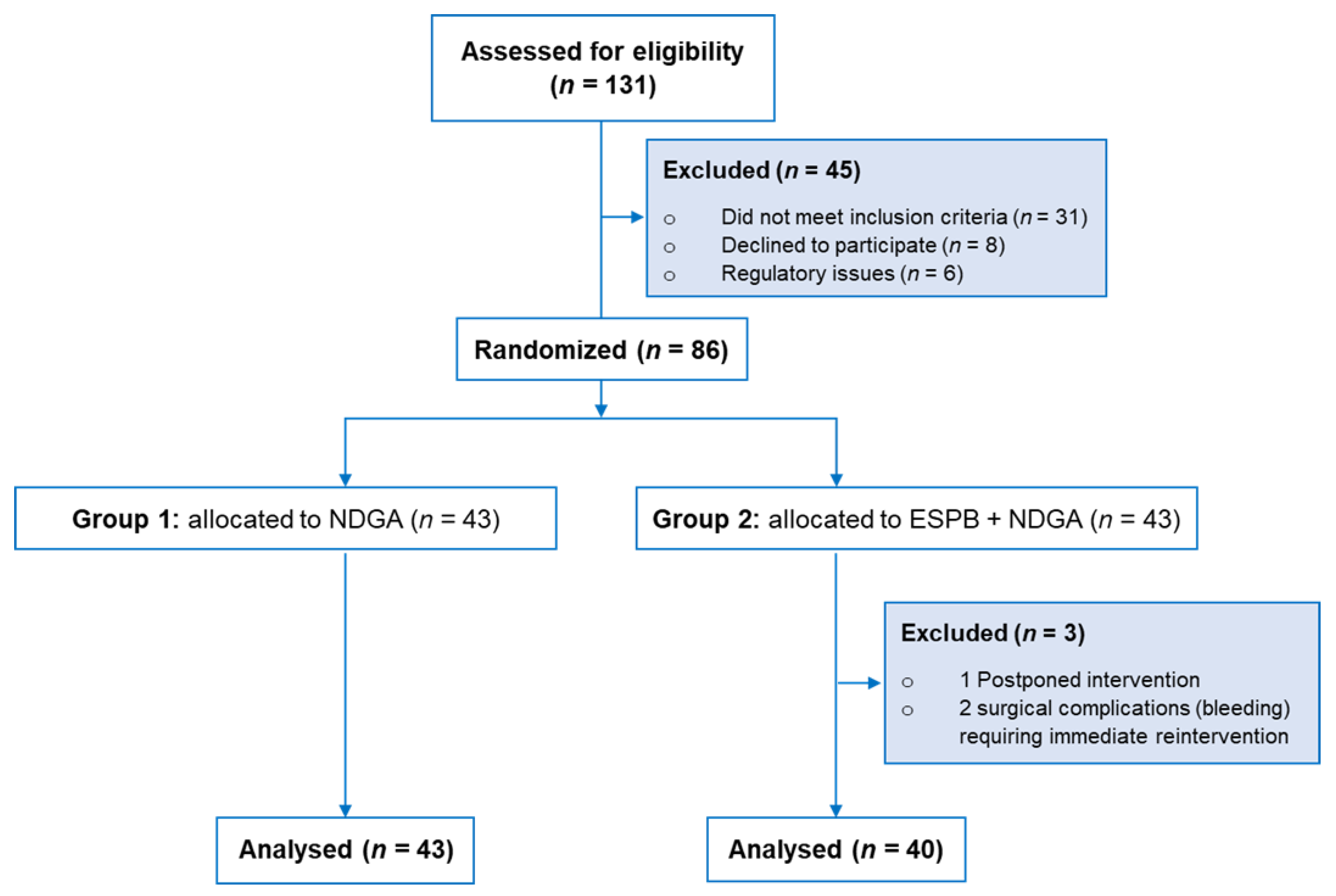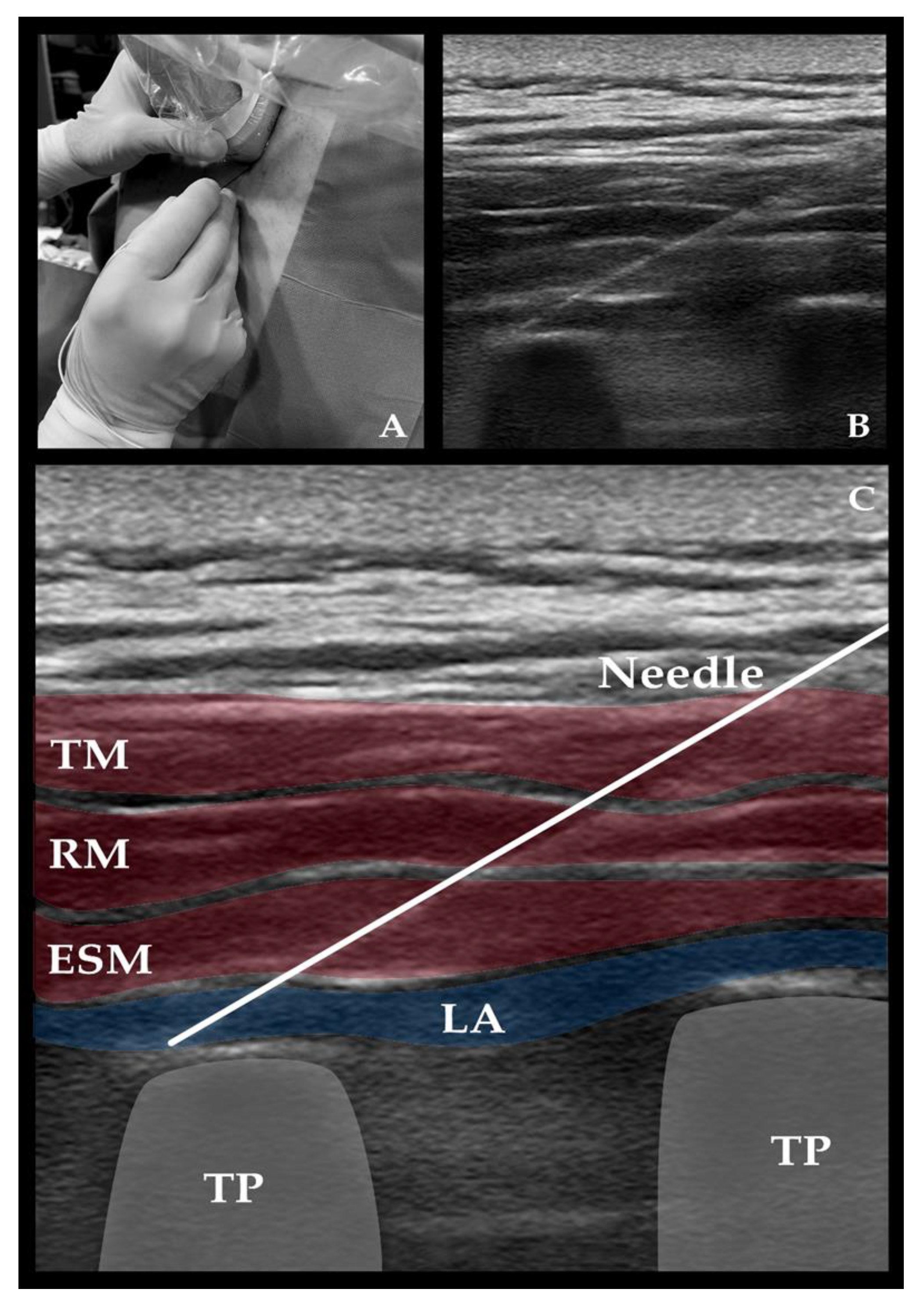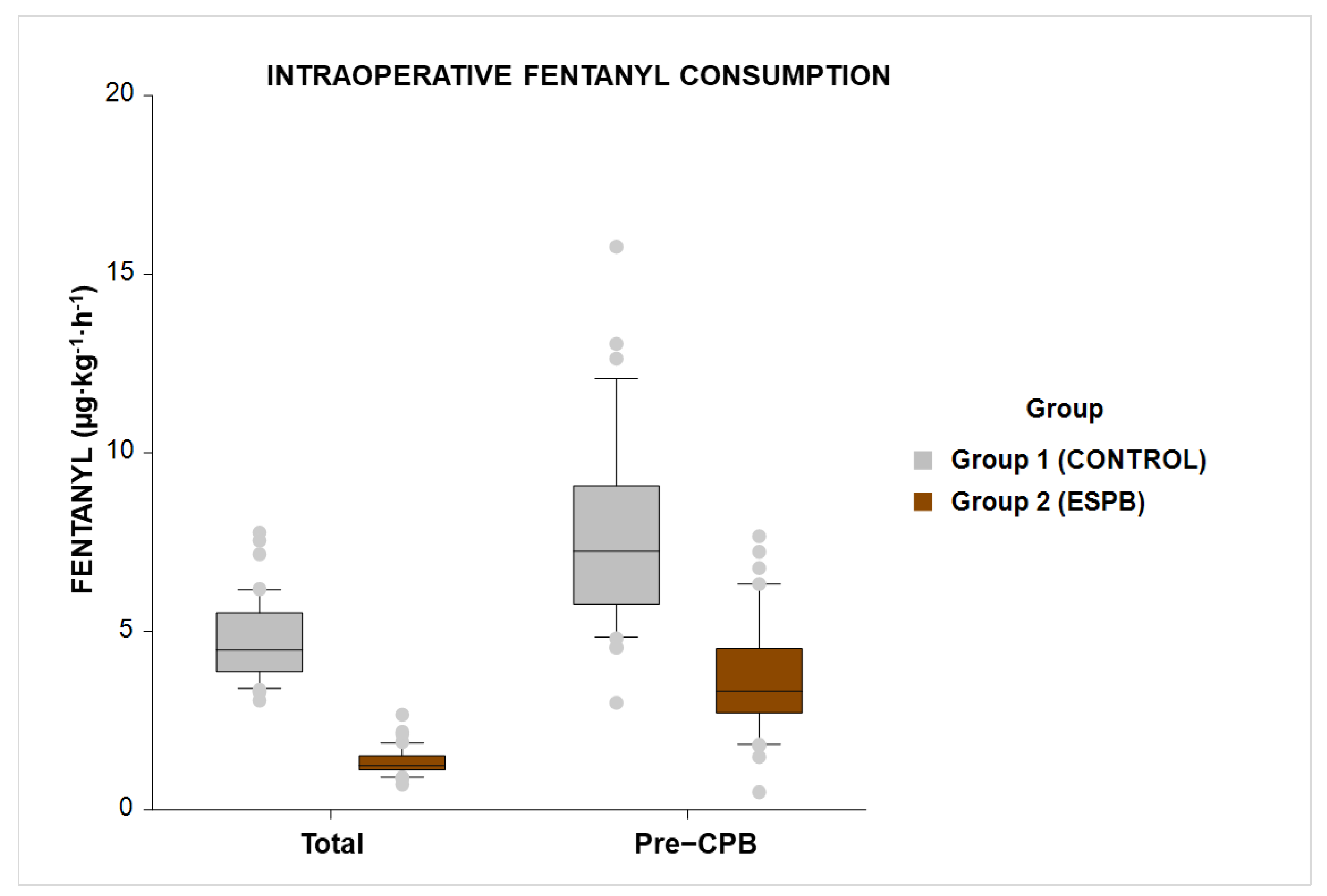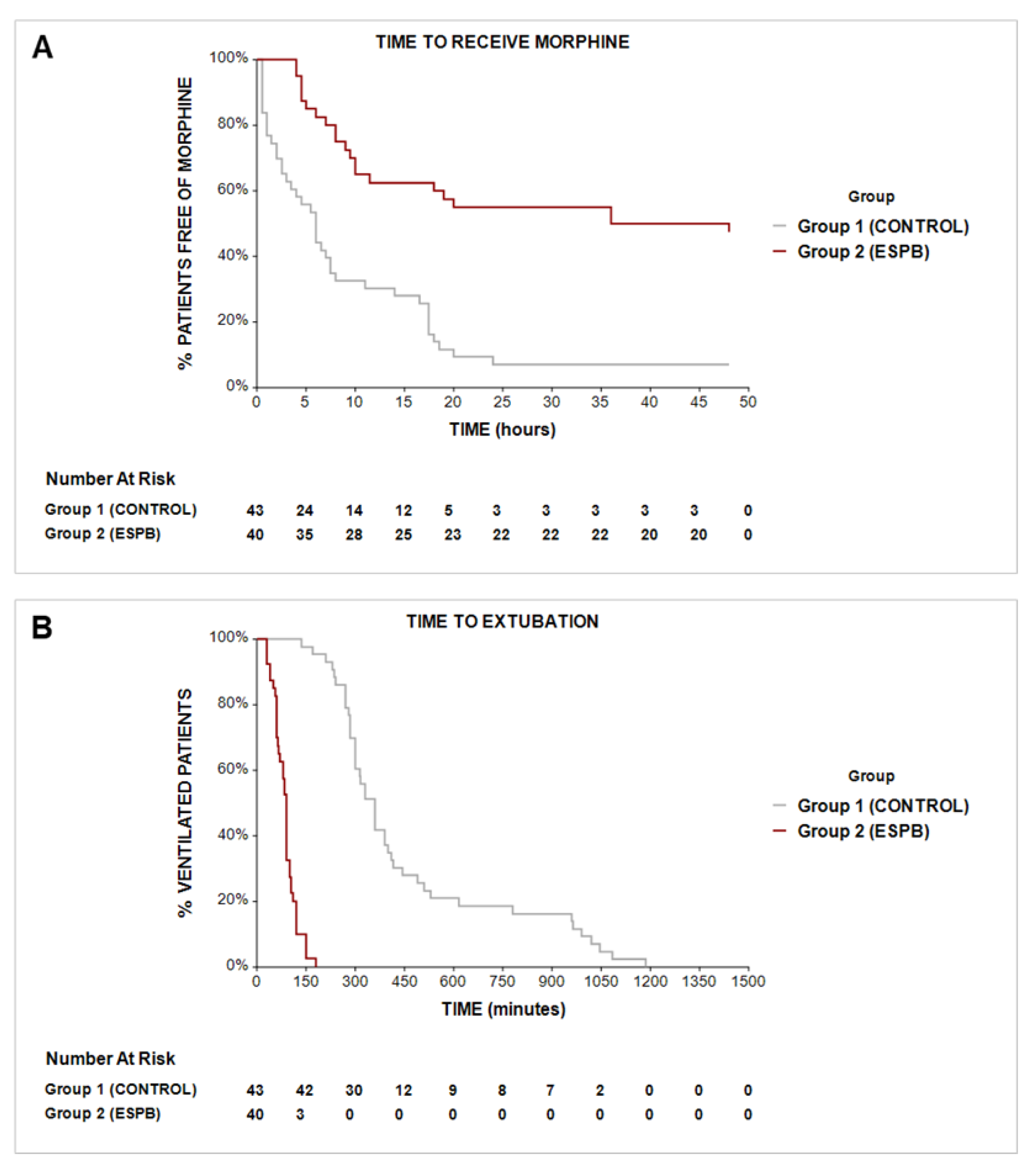Nociception Level Index-Directed Erector Spinae Plane Block in Open Heart Surgery: A Randomized Controlled Clinical Trial
Abstract
1. Introduction
2. Materials and Methods
2.1. Study Design and Patient Enrollment
2.2. Anesthesia Management
2.2.1. Preoperative
2.2.2. Intraoperative
2.2.3. Postoperative
2.3. Outcomes
2.4. Sample Size
2.5. Statistical Analysis
3. Results
3.1. Primary Outcome
3.2. Secondary Outcomes
3.2.1. Opioid Consumption
3.2.2. Quality of Analgesia
3.2.3. Fast-Tracking
3.2.4. Vasopressor Consumption
3.2.5. Length of Stay
3.3. Safety Data
3.4. Block Effectiveness
4. Discussion
5. Conclusions
Author Contributions
Funding
Institutional Review Board Statement
Informed Consent Statement
Data Availability Statement
Conflicts of Interest
References
- Cogan, J. Pain Management after Cardiac Surgery. Semin. Cardiothorac. Vasc. Anesthesia 2010, 14, 201–204. [Google Scholar] [CrossRef] [PubMed]
- Ochroch, J.; Usman, A.; Kiefer, J.; Pulton, D.; Shah, R.; Grosh, T.; Patel, S.; Vernick, W.; Gutsche, J.T.; Raiten, J. Reducing Opioid Use in Patients Undergoing Cardiac Surgery—Preoperative, Intraoperative, and Critical Care Strategies. J. Cardiothorac. Vasc. Anesthesia 2021, 35, 2155–2165. [Google Scholar] [CrossRef] [PubMed]
- Grant, M.C.; Gregory, A.J.; Ouanes, J.-P.P. Regional analgesia for cardiac surgery. Curr. Opin. Anaesthesiol. 2022, 35, 605–612. [Google Scholar] [CrossRef] [PubMed]
- Toscano, A.; Capuano, P.; Galatà, M.; Tazzi, I.; Rinaldi, M.; Brazzi, L. Safety of Ultrasound-Guided Serratus Anterior and Erector Spinae Fascial Plane Blocks: A Retrospective Analysis in Patients Undergoing Cardiac Surgery While Receiving Anticoagulant and Antiplatelet Drugs. J. Cardiothorac. Vasc. Anesthesia 2022, 36, 483–488. [Google Scholar] [CrossRef] [PubMed]
- Kelava, M.; Alfirevic, A.; Bustamante, S.; Hargrave, J.; Marciniak, D. Regional Anesthesia in Cardiac Surgery: An Overview of Fascial Plane Chest Wall Blocks. Anesthesia Analg. 2020, 131, 127–135. [Google Scholar] [CrossRef]
- Forero, M.; Adhikary, S.; Lopez, H.; Tsui, C.; Chin, K.J. The Erector Spinae Plane Block. Reg. Anesthesia Pain Med. 2016, 41, 621–627. [Google Scholar] [CrossRef]
- Krishna, S.N.; Chauhan, S.; Bhoi, D.; Kaushal, B.; Hasija, S.; Sangdup, T.; Bisoi, A.K. Bilateral Erector Spinae Plane Block for Acute Post-Surgical Pain in Adult Cardiac Surgical Patients: A Randomized Controlled Trial. J. Cardiothorac. Vasc. Anesthesia 2019, 33, 368–375. [Google Scholar] [CrossRef]
- Macaire, P.; Ho, N.; Nguyen, T.; Nguyen, B.; Vu, V.; Quach, C.; Roques, V.; Capdevila, X. Ultrasound-Guided Continuous Thoracic Erector Spinae Plane Block Within an Enhanced Recovery Program Is Associated with Decreased Opioid Consumption and Improved Patient Postoperative Rehabilitation After Open Cardiac Surgery—A Patient-Matched, Controlled Before-and-After Study. J. Cardiothorac. Vasc. Anesth. 2019, 33, 1659–1667. [Google Scholar] [CrossRef]
- Macaire, P.; Ho, N.; Nguyen, V.; Van, H.P.; Thien, K.D.N.; Bringuier, S.; Capdevila, X. Bilateral ultrasound-guided thoracic erector spinae plane blocks using a programmed intermittent bolus improve opioid-sparing postoperative analgesia in pediatric patients after open cardiac surgery: A randomized, double-blind, placebo-controlled trial. Reg. Anesthesia Pain Med. 2020, 45, 805–812. [Google Scholar] [CrossRef]
- Athar, M.; Parveen, S.; Yadav, M.; Siddiqui, O.A.; Nasreen, F.; Ali, S.; Haseen, M.A. A Randomized Double-Blind Controlled Trial to Assess the Efficacy of Ultrasound-Guided Erector Spinae Plane Block in Cardiac Surgery. J. Cardiothorac. Vasc. Anesthesia 2021, 35, 3574–3580. [Google Scholar] [CrossRef]
- Chin, K.J. Thoracic wall blocks: From paravertebral to retrolaminar to serratus to erector spinae and back again—A review of evidence. Best Pr. Res. Clin. Anaesthesiol. 2019, 33, 67–77. [Google Scholar] [CrossRef] [PubMed]
- Edry, R.; Recea, V.; Dikust, Y.; Sessler, D.I. Preliminary Intraoperative Validation of the Nociception Level Index. Anesthesiology 2016, 125, 193–203. [Google Scholar] [CrossRef] [PubMed]
- Martini, C.H.; Boon, M.; Broens, S.J.L.; Hekkelman, E.F.; Oudhoff, L.A.; Buddeke, A.W.; Dahan, A. Ability of the Nociception Level, a Multiparameter Composite of Autonomic Signals, to Detect Noxious Stimuli during Propofol–Remifentanil Anesthesia. Anesthesiology 2015, 123, 524–534. [Google Scholar] [CrossRef] [PubMed]
- Meijer, F.S.; Martini, C.H.; Broens, S.; Boon, M.; Niesters, M.; Aarts, L.; Olofsen, E.; van Velzen, M.; Dahan, A. Nociception-guided versus Standard Care during Remifentanil–Propofol Anesthesia. Anesthesiology 2019, 130, 745–755. [Google Scholar] [CrossRef]
- Bollag, L.A.; Jelacic, S.; Upegui, C.D.; Wu, C.; Richebe, P. The nociception level index (NOL) response to intubation and incision in patients undergoing video-assisted thoracoscopic surgery (VATS) with and without thoracic epidural analgesia. A pilot study. F1000Research 2018, 7, 875. [Google Scholar] [CrossRef]
- Guinot, P.-G.; Spitz, A.; Berthoud, V.; Ellouze, O.; Missaoui, A.; Constandache, T.; Grosjean, S.; Radhouani, M.; Anciaux, J.-B.; Parthiot, J.-P.; et al. Effect of opioid-free anaesthesia on post-operative period in cardiac surgery: A retrospective matched case-control study. BMC Anesthesiol. 2019, 19, 136. [Google Scholar] [CrossRef]
- Gélinas, C.; T, S.S.; Richard-Lalonde, M.; Laporta, D.; Morin, J.-F.; Boitor, M.; E Ferland, C.; Bourgault, P.; Richebé, P. Exploration of a Multi-Parameter Technology for Pain Assessment in Postoperative Patients After Cardiac Surgery in the Intensive Care Unit: The Nociception Level Index (NOL)TM. J. Pain Res. 2021, 14, 3723–3731. [Google Scholar] [CrossRef]
- Kaushal, B.; Chauhan, S.; Magoon, R.; Krishna, N.; Saini, K.; Bhoi, D.; Bisoi, A.K. Efficacy of Bilateral Erector Spinae Plane Block in Management of Acute Postoperative Surgical Pain After Pediatric Cardiac Surgeries Through a Midline Sternotomy. J. Cardiothorac. Vasc. Anesthesia 2020, 34, 981–986. [Google Scholar] [CrossRef]
- Zhang, J.; He, Y.; Wang, S.; Chen, Z.; Zhang, Y.; Gao, Y.; Wang, Q.; Xia, Y.; Papadimos, T.J.; Zhou, R. The erector spinae plane block causes only cutaneous sensory loss on ipsilateral posterior thorax: A prospective observational volunteer study. BMC Anesthesiol. 2020, 20, 88. [Google Scholar] [CrossRef]
- Chin, K.J.; El-Boghdadly, K. Mechanisms of action of the erector spinae plane (ESP) block: A narrative review. Can. J. Anaesth. 2021, 68, 387–408. [Google Scholar] [CrossRef]
- Tomar, G.S.; Ganguly, S.; Cherian, G. Effect of Perineural Dexamethasone With Bupivacaine in Single Space Paravertebral Block for Postoperative Analgesia in Elective Nephrectomy Cases: A Double-Blind Placebo-Controlled Trial. Am. J. Ther. 2017, 24, e713–e717. [Google Scholar] [CrossRef] [PubMed]
- Saleh, A.H.; Hassan, P.F.; Elayashy, M.; Hamza, H.M.; Abdelhamid, M.H.; Madkour, M.A.; Tawadros, P.Z.; Omar, H.; Kamel, M.M.; Zayed, M.; et al. Role of dexamethasone in the para-vertebral block for pediatric patients undergoing aortic coarctation repair. Randomized, double-blinded controlled study. BMC Anesthesiol. 2018, 18, 178. [Google Scholar] [CrossRef] [PubMed]
- Pehora, C.; Pearson, A.M.; Kaushal, A.; Crawford, M.W.; Johnston, B. Dexamethasone as an adjuvant to peripheral nerve block. Cochrane Database Syst. Rev. 2017, 2017, CD011770. [Google Scholar] [CrossRef] [PubMed]
- Zhang, P.; Liu, S.; Zhu, J.; Rao, Z.; Liu, C. Dexamethasone and dexmedetomidine as adjuvants to local anesthetic mixture in intercostal nerve block for thoracoscopic pneumonectomy: A prospective randomized study. Reg. Anesthesia Pain Med. 2019, 44, 917–922. [Google Scholar] [CrossRef]
- Ahonen, J.; Olkkola, K.; Hynynen, M.; Seppälä, T.; Ikävalko, H.; Remmerie, B.; Salmenperä, M. Comparison of alfentanil, fentanyl and sufentanil for total intravenous anaesthesia with propofol in patients undergoing coronary artery bypass surgery†. Br. J. Anaesth. 2000, 85, 533–540. [Google Scholar] [CrossRef] [PubMed]
- Statzer, N.J.; Plackis, A.C.; Woolard, A.A.; Allen, B.F.S.; Siegrist, K.K.; Shi, Y.; Shotwell, M. Erector Spinae Plane Catheter Analgesia in Minimally Invasive Mitral Valve Surgery: A Retrospective Case–Control Study for Inclusion in an Enhanced Recovery Program. In Seminars in Cardiothoracic and Vascular Anesthesia; SAGE Publications: Los Angeles, CA, USA, 2022. [Google Scholar] [CrossRef]
- McGuirk, S.; Fahy, C.; Costi, D.; Cyna, A.M. Use of invasive placebos in research on local anaesthetic interventions. Anaesthesia 2011, 66, 84–91. [Google Scholar] [CrossRef]




| Parameter | Control (n = 43) | ESPB (n = 40) |
|---|---|---|
| Demographics | ||
| Age, years | 63 (55–69) | 61.5 (52–66) |
| Gender, male | 26 [60.5] | 26 [65] |
| BMI, kg/m2 | 29.6 ± 4.9 | 28.9 ± 3.9 |
| Weight, kg | 82.8 ± 14.1 | 84.1 ± 13.3 |
| Surgery Characteristics | ||
| Duration of surgery, minutes | 296.8 ± 64.1 | 286 ± 58.4 |
| CPB time, minutes | 95 (82–106) | 90 (69.2–111.5) |
| Aortic cross–clamp time, minutes | 66 (56–82) | 58 (42.5–81.2) |
| Surgical Procedures | ||
| CABG | 19 [44.2] | 16 [40] |
| CABG + valve replacement | 3 [7] | 4 [10] |
| AVR | 15 [34.9] | 9 [22.5] |
| MVR | 1 [2.3] | 6 [15] |
| AVR + MVR | 1 [2.3] | 0 [0] |
| ASD repair | 0 [0] | 2 [5] |
| VSD repair | 0 [0] | 1 [2.5] |
| Myxoma resection | 2 [4.6] | 1 [2.5] |
| AAA repair | 2 [4.6] | 1 [2.5] |
| Medical History | ||
| Hypertension | 41 [95.3] | 36 [90] |
| Diabetes mellitus | 8 [18.6] | 9 [22.5] |
| Heart failure | 43 [100] | 40 [100] |
| Stroke | 4 [9.3] | 4 [10] |
| Chronic kidney disease | 4 [9.3] | 6 [15] |
| Endocarditis | 0 [0] | 3 [7.5] |
| Myocardial infarction | 7 [16.3] | 11 [27.5] |
| Extracardiac arteriopathy | 9 [20.9] | 15 [37.5] |
| Chronic opioid therapy | 0 [0] | 0 [0] |
| Preoperative Risk and Heart Function | ||
| EuroSCORE II | 1.07 (0.76–1.39) | 1.02 (0.86–1.56) |
| LVEF, % | 55.0 (50–60) | 52.5 (50–60) |
| Intraoperative Monitoring § | ||
| Heart rate, bpm | 84 (75–90) | 88 (77.7–90) |
| Mean arterial pressure, mmHg | 67.2 ± 8.1 | 65.9 ± 7.5 |
| Lactate, mmol/L | 1.4 (1.1–1.6) | 1.3 (1–1.7) |
| NOL index > 25 | 3 [7] | 0 [0] |
| BIS | 45 (41–47) | 43 (41–48) |
| Outcomes | Control (n = 43) | ESPB (n = 40) | p Value |
|---|---|---|---|
| Primary outcome | |||
| Total intraoperative fentanyl consumption, µg·kg−1·h−1 | 4.5 (3.8–5.5) | 1.2 (1.1–1.5) | <0.001 # |
| Secondary outcomes | |||
| Opioid consumption | |||
| Pre–CPB intraoperative fentanyl consumption, µg·kg−1·h−1 | 7.2 (5.7–9) | 3.3 (2.7–4.5) | <0.001 |
| Morphine consumption 0–48 h, µg/kg | 60.6 (40–95.7) | 22.1 (0–40.4) | <0.001 |
| Morphine-free patients 48 h after ICU admission | 3 [7] | 19 [47.5] | <0.001 |
| Time to first dose of morphine, minutes | 345 (67.5–795) | 540 (285–1110) | 0.008 |
| Quality of analgesia ‡ | |||
| NRS score immediately postextubation | 2 (2–4) | 1 (0–2) | <0.001 |
| NRS score 6 h postextubation | 4 (3–5) | 2 (1–3) | <0.001 |
| NRS score 12 h postextubation | 4 (3–4) | 2 (1–3) | <0.001 |
| NRS score 24 h postextubation | 3 (2–4) | 2 (0–3) | <0.001 |
| NRS score 48 h postextubation | 2 (1–4) | 1 (1–2) | 0.001 |
| NRS score 1 h after drain removal | 2 (1–3) | 2 (1–3) | 0.261 |
| Fast–tracking | |||
| Time to extubation, minutes | 360 (285–510) | 90 (60–105) | <0.001 |
| Extubated patients 2 h after ICU admission | 0 [0] | 35 [87.5] | <0.001 |
| Vasopressor consumption | |||
| Intraoperative NE consumption, µg·kg−1·h−1 | 1.1 (0.6–2.2) | 1.9 (0.6–3.1) | 0.147 |
| NE consumption 0–12 h after ICU admission, µg/kg | 9 (0–32.3) | 0 (0–1.3) | <0.001 |
| Time to wean off NE after ICU admission, minutes | 240 (0–720) | 0 (0–60) | <0.001 |
| NE-free patients 2 h after ICU admission | 20 [46.5] | 35 [87.5] | <0.001 |
| Length of stay | |||
| ICU LOS, days | 2 (2–3) | 3 (2–4) | 0.102 |
| Hospital LOS, days | 7 (7–9) | 8 (7–9.75) | 0.598 |
| Events | Control (n = 43) | ESPB (n = 40) | p Value |
|---|---|---|---|
| Opioid-related | |||
| Pruritus | 1 [2.3] | 0 [0] | NS |
| PONV | 3 [7] | 0 [0] | NS |
| Respiratory depression # | 1 [2.3] | 0 [0] | NS |
| Arrhythmia | |||
| POAF | 4 [9.3] | 5 [12.5] | NS |
| ESPB-related | |||
| Hematoma | N/A | 0 [0] | N/A |
| LAST | N/A | 0 [0] | N/A |
| Pneumothorax | N/A | 0 [0] | N/A |
Publisher’s Note: MDPI stays neutral with regard to jurisdictional claims in published maps and institutional affiliations. |
© 2022 by the authors. Licensee MDPI, Basel, Switzerland. This article is an open access article distributed under the terms and conditions of the Creative Commons Attribution (CC BY) license (https://creativecommons.org/licenses/by/4.0/).
Share and Cite
Balan, C.; Tomescu, D.R.; Valeanu, L.; Morosanu, B.; Stanculea, I.; Coman, A.; Stoian, A.; Bubenek-Turconi, S.I. Nociception Level Index-Directed Erector Spinae Plane Block in Open Heart Surgery: A Randomized Controlled Clinical Trial. Medicina 2022, 58, 1462. https://doi.org/10.3390/medicina58101462
Balan C, Tomescu DR, Valeanu L, Morosanu B, Stanculea I, Coman A, Stoian A, Bubenek-Turconi SI. Nociception Level Index-Directed Erector Spinae Plane Block in Open Heart Surgery: A Randomized Controlled Clinical Trial. Medicina. 2022; 58(10):1462. https://doi.org/10.3390/medicina58101462
Chicago/Turabian StyleBalan, Cosmin, Dana R. Tomescu, Liana Valeanu, Bianca Morosanu, Iulia Stanculea, Antonia Coman, Anca Stoian, and Serban I. Bubenek-Turconi. 2022. "Nociception Level Index-Directed Erector Spinae Plane Block in Open Heart Surgery: A Randomized Controlled Clinical Trial" Medicina 58, no. 10: 1462. https://doi.org/10.3390/medicina58101462
APA StyleBalan, C., Tomescu, D. R., Valeanu, L., Morosanu, B., Stanculea, I., Coman, A., Stoian, A., & Bubenek-Turconi, S. I. (2022). Nociception Level Index-Directed Erector Spinae Plane Block in Open Heart Surgery: A Randomized Controlled Clinical Trial. Medicina, 58(10), 1462. https://doi.org/10.3390/medicina58101462





